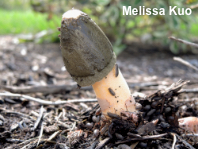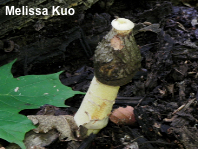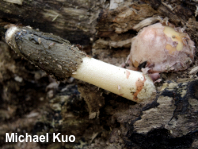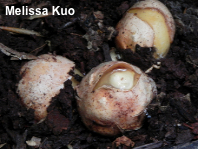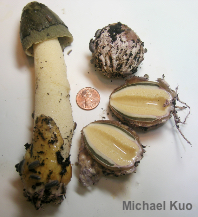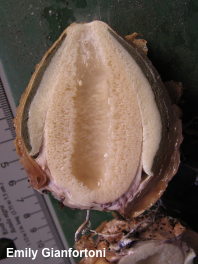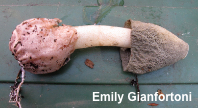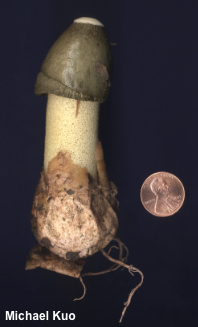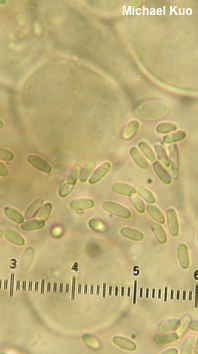| Major Groups > Stinkhorns > Phallus ravenelii |

|
Phallus ravenelii [ Basidiomycota > Agaricomycetes > Phallales > Phallaceae > Phallus . . . ] by Michael Kuo This eastern North American stinkhorn is easily distinguished by its smooth—rather than pitted and ridged—cap surface. Like the similar-looking Phallus impudicus it is often found in lawns, gardens, and cultivated areas, though it also grows in woods. It develops from an underground "egg," and when mature it is covered with a foul-smelling brown or olive brown slime which attracts flies and other insects (who then, in turn, disperse the mushroom's spores). Thanks to Emily Gianfortoni, Roger Heidt, and Nathan Wilson for documenting, collecting, and preserving Phallus ravenelii for study; their collections are deposited in The Herbarium of Michael Kuo. Description: Ecology: Saprobic; growing alone or gregariously in gardens, flowerbeds, meadows, lawns, woodchips, sawdust piles, cultivated areas, and so on—also in woods, often in the vicinity of rotting wood, or growing directly from well-rotted logs; usually appearing in fall (also over winter during warm spells and in warmer climates); originally described from South Carolina; widely distributed in North America from Mexico to eastern Canada and the Midwestern, southeastern, and northeastern United States. The illustrated and described collections are from Illinois, Indiana, Iowa, Massachusetts, and Virginia. Immature Fruiting Body: Like a whitish to purplish or pink "egg" 3–6 cm high and 2–4 cm wide; egg-shaped or nearly round; base attached to white rhizomorphs; when sliced revealing the whitish stinkhorn-to-be encased in a brownish gelatinous substance. Mature Fruiting Body: Cylindric, with a clearly differentiated head structure that sits thimble-like atop the step. Head: 3–5 cm high; attached to the top of the stem; broadly conic or nearly so; soon becoming perforated at the apex, with the perforation surrounded by a sterile whitish "lip" (the sterile lip is present even in the "egg" stage); smooth or granular and slightly wrinkled; creamy to dull grayish brown, covered with darker brown spore slime; sometimes with patches of purplish to pinkish universal veil. Stem: 10–17 cm high; 2–3.5 cm thick; slightly tapered to apex; dry; creamy to pale yellowish; pocketed with 1–2 declivities per mm; hollow; base enclosed in a pink to purplish volva 2–5 cm high; attached to white or pink rhizomorphs. Microscopic Features: Spores 2.5–4 x 1–1.5 µm; subcylindric; smooth; hyaline to yellowish in KOH. Sphaerocysts of the pseudostipe 12–70 µm; irregularly subglobose; smooth; walls 0.5–1 µm thick; hyaline in KOH. Hyphae of the volva 2–10 µm wide; smooth; thin-walled; hyaline in KOH; clamp connections present. REFERENCES: Berkeley & M. A. Curtis, 1876. (Coker & Couch, 1928; Smith, Smith & Weber, 1981; Lincoff, 1992; Metzler & Metzler, 1992; Barron, 1999; Calonge, 2005; McNeil, 2006; Miller & Miller, 2006; Hosaka, 2010; Kuo & Methven, 2010; Degreef et al., 2013; Kuo & Methven, 2014; Marincowitz et al., 2015; Baroni, 2017; Woehrel & Light, 2017; Sturgeon, 2018.) Herb. Kuo 09300509, 09081203, 10081202, 12121301, 09181801, 10071802. This site contains no information about the edibility or toxicity of mushrooms. |
© MushroomExpert.Com |
|
Cite this page as: Kuo, M. (2021, January). Phallus ravenelii. Retrieved from the MushroomExpert.Com Web site: http://www.mushroomexpert.com/phallus_ravenelii.html |
